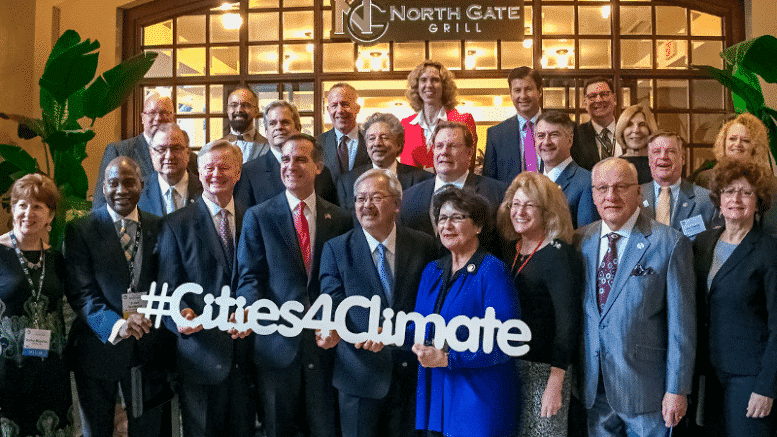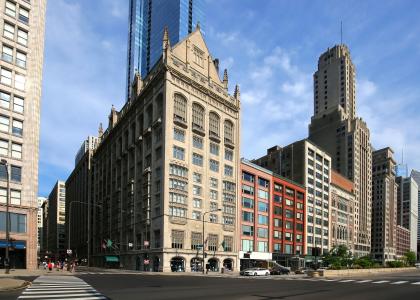Policies and strategies for new and existing buildings
Buildings are the top energy user in most cities, accounting for approximately 50-75% of citywide energy use.1 With energy efficiency policies that reduce such energy use, cities can increase economic opportunities for residents, make progress toward environmental goals and outcomes, and improve energy affordability.
As of January 2018, 391 US mayors have committed to adopt the Paris Climate Agreement goals and reduce their citywide carbon emissions. To meet these emissions-reduction requirements, buildings policies will be crucial.2 Photo source: https://www.technocracy.news/wp-content/uploads/2017/06/cities-for-climate-change-777x437.png
When a city enacts a policy, the savings depend on numerous factors, such as the scope of the policy (e.g., how many buildings are affected), the implementation, and the energy use of the affected buildings (e.g., size, age, levels of efficiency). Local governments can enact buildings policies that affect new and existing buildings. Depending on the age and efficiency of existing buildings and the planned construction of new buildings, cities will achieve varying energy savings with the following policies.
Policies for New Buildings
Building Energy Codes and Code Compliance
Today’s building energy codes provide 30% savings compared to those of less than a decade ago and save consumers $5 billion in annual energy use.3 From 2010 to 2040, projected US savings from these codes are estimated to be $126 billion, 841 MMT of carbon emissions, and 12.8 quads of energy.4
Even though the United States does not have a uniform national building energy code, the federal government does participate in developing the model national building codes, which states and cities can adopt. The national model code for residential buildings is the International Energy Conservation Code (IECC), and the model code for commercial buildings is the American Society of Heating, Refrigerating and Air-Conditioning Engineers (ASHRAE) Standard 90.1. The federal government encourages states to adopt and implement the newest energy codes. Some states cede authority to cities to determine building codes, while others allow cities to adopt their own local building codes that are stricter than the state codes. In cases where cities do not have the jurisdiction to adopt new building codes, they can petition to the state for updated building codes, in line with the newest residential IECC and commercial ASHRAE codes.
Depending on the stringency of current codes, cities can achieve a range of savings from updating their codes to the most stringent ones, 2015 IECC and ASHARE 90.1-2016. For example, by upgrading to the newest codes:
To achieve these savings, the codes must be enforced. Code compliance can be challenging for cities because of limited resources, inadequate training, or lack of awareness.6 Low compliance rates lead to lost energy savings. The Institute for Market Transformation estimated that in one Mid-Atlantic city, multifamily buildings were spending $0.50 more per square foot for energy costs due to non-compliance, which added up to more than $1.5 million in unnecessary energy costs annually for a typical building.7
Mayors can act as leaders by supporting compliance goals, conducting baseline studies, evaluating results, and providing ongoing quality assurance. Cities can also dedicate internal staff to code compliance, enact a mandatory compliance program, and offer compliance training and support. For example, Seattle has internal staff dedicated solely to energy code compliance and requires that building owners hire specialists for inspections of energy code-related projects. Before the permit application process, project applicants may meet with energy and mechanical review. Seattle also requires building code officials to receive training on energy code plan review and inspection.8
Green Building Requirements
Local governments can enact policies that require specific building types (e.g., public buildings or buildings of a certain square footage) to obtain a green building label. The two most prominent labels are the Leadership in Energy and Environmental Design (LEED) label and the ENERGY STAR® buildings label. These programs bolster each other because ENERGY STAR provides many of the tools and resources that building owners also need for LEED certifications.9
Many cities have requirements or incentives for new green buildings, such as requiring those over a certain square footage to obtain labels or providing monetary or policy incentives to building owners who earn green buildings labels. For example, Miami requires all new large commercial and multifamily buildings to achieve LEED Silver certification. Similarly, Washington, DC, requires green building certification for all new non-residential buildings. Washington currently leads the country in square footage of LEED and ENERGY STAR certified buildings per capita.12
Policies for Existing Buildings
Energy Audit, Retrofit, and Retrocommissioning Requirements
To improve the efficiency of existing buildings, local governments can enact energy audit, retrofit, and retrocommissioning policies.
Energy Audits
Local governments can set requirements for energy audits based on milestones, such as time of sale, period of time, or compliance period for benchmarking polices. Energy audits help building owners identify areas for possible energy efficiency improvements. Local governments can take steps to require energy audits for specific buildings. For example, Boston’s 2013 Building Energy Reporting and Disclosure Ordinance requires residential and commercial buildings that are not ENERGY STAR certified or do not have documented energy reductions to take an “energy action” such as an energy audit.13
Retrofits and Retrocommissioning
Building retrofits refer to modifications to existing buildings that lead to energy savings with a particular emphasis on equipment upgrades and building envelope improvements. Energy audits identify the energy efficiency upgrades that can be achieved through a retrofit. Efficiency retrofits after energy audits can typically reduce energy bills by 5-30%.14 Comprehensive upgrades can reduce commercial building use by 20-50%.15 Some cities have retrofit requirements for certain buildings.
Cities have begun encouraging building retrofits. For example, San Francisco’s Residential Energy Conservation Ordinance requires a minimum set of retrofits at time of sale for residential properties built before 1978.16 Similarly, the city of Boulder’s Smart Regs program requires single and multifamily-rental homes to reach a certain level of energy efficiency by 2019. If compliance is not achieved, retrofits will be required.17 The New York City Mayor’s Office of Sustainability launched a Retrofit Accelerator program in 2015 to help provide building owners and decision makers with a streamlined process for increasing building retrofits. As of November 2017, the New York City Retrofit Accelerator was working with more than 2,300 properties on 5,000 identified efficiency projects, with more than 1,600 completed to date. If all 5,000 projects are completed, the city will reduce its annual GHG emissions by nearly 153,600 metric tons of carbon dioxide, which is equivalent to getting 33,000 cars off the road for a year.18
Retrocommissioning (RCx) is the process of improving existing building efficiency by improving the operation and maintenance of equipment and systems rather than more costly capital investments. RCx can often lead to significant energy savings at minimal cost. Commercial buildings offer an opportunity to achieve substantial energy savings through energy audits and RCx. The EPA estimates that commercial projects have a median cost of $0.27 per square foot and 15% energy savings, with a payback period of 8-9 months.19 With a retrocommissioning requirement, cities can ensure that large buildings are periodically evaluated for energy saving opportunities, and that these opportunities are realized. For example, Orlando’s Building Energy and Water Efficiency Strategy requires that as of May 2020, buildings that score under the national average (i.e., ENERGY STAR score below 50) will be required to perform an energy audit or retrocommission their base building systems once every five years.20
Benchmarking and Transparency Policies
Building benchmarking and transparency (B&T) policies have been gaining traction at the city level in recent years. As of September 2017, 26 US jurisdictions have adopted B&T policies that require reporting of energy consumption for privately owned commercial and/or multifamily buildings.21 The Lawrence Berkeley National Laboratory (LBNL) compiled the impact of policies from eight cities and found that, on average, benchmarking policies resulted in energy reductions of 3 to 8% over a two-to four-year period.22 LBNL indicates that these results should be considered preliminary due to the need for more rigorous and longer-term analyses. More rigorous analyses are needed to predict conclusive energy savings from B&T policies. In addition, ENERGY STAR Portfolio Manager® conducted a study of more than 35,000 buildings in its benchmarking system from 2008 to 2011 and found a total of 7% energy savings over the three-year period.23
While these policies do not directly require energy efficiency improvements, they do motivate some building owners to take action. Furthermore, energy consumption data are critical for quantifying and evaluating building energy use patterns to achieve citywide energy savings. Benchmarking policies are continuing to advance nationally, and they provide a promising opportunity to save energy. For example, Atlanta’s Commercial Buildings Energy and Water Efficiency Ordinance aims to achieve 20% commercial energy reduction by 2020 by using annual energy and water benchmarking requirements to address information barriers.24 Atlanta also provides training sessions to help ensure benchmarking compliance.
In addition, some cities have enacted energy disclosure requirements for buildings at time of sale. For example, the City of Portland Home Energy Score ordinance, which took effect as of 2018, requires sellers of single-family homes to disclose a Home Energy Report and Score at the time of listing.25 Similarly, Austin’s Energy Conservation Audit and Disclosure Ordinance requires all homes and multifamily buildings of more than five units that are at least 10 years old to have an energy audit performed at the time of sale, with results disclosed to prospective buyers. High energy-consuming multifamily buildings are required to reduce energy use.26
For more information or to contact a researcher, please visit the Local Policy research program.
[1] Ribeiro, D., T. Bailey, A. Drehobl, J. King, S. Samarripas, M. Shoemaker, S. Vaidyanathan, W. Beg, and F. Castro-Alvarez. 2017. The 2017 City Energy Efficiency Scorecard. Washington, DC: American Council for an Energy-Efficient Economy. aceee.org/research-report/u1705.
[2] Climate Mayors. 2018. “Paris Climate Agreement” Accessed January 19, 2018. climatemayors.org/actions/paris-climate-agreement.
[3] Department of Energy. 2016. “Saving Energy and Money with Building Energy Codes in the United States.” Department of Energy Efficiency and Renewable Energy. energy.gov/sites/prod/files/2016/08/f33/Codes%20Fact%20Sheet%208-25-16.pdf.
[4] Department of Energy. N.d. “The Impact of Building Energy Codes. Accessed February 6, 2018. www.energycodes.gov/about/results.
[5] Savings estimates courtesy of the Pacific Northwest National Laboratory. See: Rosenberg, M., D. Jonlin, and S. Nadel. 2016. A Perspective of Energy Codes and Regulations for the Buildings of the Future. Journal of Solar Energy Engineering 139 (1). Doi: 10.1115/1.4034825.
[6] National Resource Defense Council & Institute for Market Transformation. 2016. Establishing a Plan to Achieve Energy Code Compliance in Cities. City Energy Project. http://www.cityenergyproject.org/wp-content/uploads/2016/11/CEP-Establishing-a-Plan-to-Achieve-Energy-Code-Compliance-in-Cities_2016Final.pdf.
[7] Institute for Market Transformation and National Resources Defense Council. 2017. Evaluating Energy Code Compliance in Cities. City Energy Project. November. www.cityenergyproject.org/wp-content/uploads/2017/11/CEP_Compliance-Assessment-Overview-IMT_2017-1.pdf.
[8] ACEEE. 2017. “Energy Code Compliance”. State and Local Policy Database. database.aceee.org/city/energy-code-compliance.
[9] Blackwelder, A. 2017. “Energy Star and LEED work together for private-sector energy efficiency”. 27 April. US Green Building Council. https://www.usgbc.org/articles/energy-star-and-leed-work-together-privatesector-energy-efficiency.
[10] Fowler, K., E. Rauch, J. Henderson, and A. Kora. 2011. Re-Assessing Green Building Performance: A Post Occupancy Evaluation of 22 GSA Buildings. Pacific Northwest National Laboratory. www.pnnl.gov/main/publications/external/technical_reports/PNNL-19369.pdf.
[11] Energy Star. N.d. “Media FAQs about ENERGYS TAR for commercial and industrial buildings.” US Department of Energy. Accessed February 21, 2018. www.energystar.gov/buildings/press-room/media-faqs.
[12] DC Department of Energy. N.d. “Green Buildings”. Accessed February 2018. doee.dc.gov/service/green-buildings.
[13] City of Boston, MA. N.d. “Building Energy Reporting and Disclosure Ordinance.” www.boston.gov/environment-and-energy/building-energy-reporting-and-disclosure-ordinance.
[14] Department of Energy. 2013. Energy Saver 101 Infographic: Home Energy Audits. August 15. energy.gov/articles/energy-saver-101-infographic-home-energy-audits.
[15] York, D., S. Nadel, E. Rogers, R. Cluett, S. Kwatra, H. Sachs, J. Amann, and M. Kelly. 2015. New Horizons for Energy Efficiency: Major Opportunities to Reach Higher Electricity Savings by 2030. Washington, DC: ACEEE. aceee.org/research-report/u1507.
[16] City of San Francisco, CA. N.d. “Residential Energy Conservation Ordinance.” Accessed February 21, 2018. sfenvironment.org/residential-energy-conservation-ordinance.
[17] City of Boulder, CO. N.d. “SMARTREGS”. Accessed February 21, 2018. bouldercolorado.gov/plan-develop/smartregs.
[18] Institute for Market Transformation. 2018. Successful Partnerships to Accelerate Efficiency: NYC Retrofit Accelerator”. http://www.imt.org/uploads/resources/files/PuttingDatatoWork_NYCRetrofitAccelerator.pdf.
[19] Environmental Protection Agency. “Media FAQs about ENERGY STAR for commercial and industrial buildings”. Accessed January 19, 2018. www.energystar.gov/buildings/press-room/media-faqs.
[20] City of Orlando, FL. N.d. “Building Energy and Water Efficiency Strategy.” Accessed February 21, 2018. www.cityoforlando.net/greenworks/building-energy-and-water-efficiency-strategy/.
[21] Institute for Market Transformation. 2017. “US Building Benchmarking Policy Landscape.” Accessed February 23, 2018. www.buildingrating.org/graphic/us-building-benchmarking-policy-landscape.
[22] Mims, N., S. Schiller, E. Stuart, L. Schwartz, C. Kramer, and R. Faesy. 2017. Evaluation of U.S. Building Energy Benchmarking and Transparency Programs: Attributes, Impacts, and Best Practices. Lawrence Berkeley National Laboratory. emp.lbl.gov/sites/default/files/lbnl_benchmarking_final_050417_0.pdf.
[23] Energy Star Portfolio Manager. 2012. “Benchmarking and Energy Savings.” DataTrends. www.energystar.gov/sites/default/files/buildings/tools/DataTrends_Savings_20121002.pdf
[24] City of Atlanta, GA. N.d. “Atlanta Commercial Buildings Energy & Water Efficiency Ordinance.” Accessed February 21, 2018. atlantabuildingefficiency.com/.
[25] City of Portland, OR. N.d. “The City of Portland Home Energy Score.” Office of Planning and Sustainability. www.portlandoregon.gov/bps/71421.
[26] Austin Energy. N.d. “Energy Conservation Audit and Disclosure Ordinance.” Accessed February 21, 2018. austinenergy.com/ae/energy-efficiency/ecad-ordinance/energy-conservation-audit-and-disclosure-ordinance.





